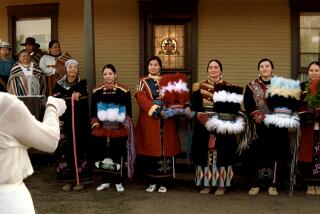How the Midwest was won
- Share via
Disaster struck the family of Pierre Chouteau on the evening of Feb. 15, 1805. Their home, one of the finest in the city of St. Louis, burned to the ground. No one was hurt. But in “the space of one hour [Pierre] saw the flames devour the fruits of 25 years of unremitting work.” His shock became acute when he concluded that one of his female slaves had started the fire.
In his hour of need, Chouteau, a member of a powerful family in the interior of North America, looked for relief from the president of the United States. He trusted that Thomas Jefferson would continue “the interest which you have always been pleased to show me and which I shall endeavor to merit all my life.” He flattered himself that his children would find in the president “a protector and that they can, by your help, found for themselves a fortune which I have no longer the hope of leaving them.”
Known to everyone as Cadet, Chouteau had met Jefferson in Washington, D.C., the previous summer, after France transferred to the United States the vast territory Americans call the Louisiana Purchase. He arrived in the capital of the new imperial republic accompanied by 14 Osage Indians, his son and his nephew. Jefferson had appointed Cadet “agent of Indian Affairs for the district of Upper Louisiana” and given him an annual income of $1,500. And the president assured the Osages that they would never again “have occasion to change [their] fathers. We are all now of one family, born in the same land, and bound to live as brothers.”
Jefferson’s benevolence was rooted in self-interest: He needed the Chouteaus and the Osages. The success of the American conquest of the Missouri Valley depended on the cooperation of the French and Indians who already inhabited the region. It was hardly coincidental that the famous expedition of explorers Meriwether Lewis and William Clark departed St. Louis for points west within days of the Chouteaus’ departure for Washington, D.C.
In a book whose title should have been “Before and After Lewis and Clark,” Shirley Christian details the efforts of the Chouteaus to deal with the failure of Americans to live up to Jefferson’s promise of mutual accommodation. She contrasts the apparent French tolerance of Indians with the intolerance of the Americans, and she traces the rise of a multicultural world and then its collapse into confrontation and separation.
Christian’s method is genealogical, interweaving biographies of the male members of the Chouteau family. To start, she explains that Cadet Chouteau was not really a Chouteau. His father, Pierre Laclede, was born in the lower Pyrenees in 1729 and migrated to the French settlement of New Orleans during the Seven Years’ War (1756-63). There he became the protege of a well-connected merchant as well as the lover of Marie Therese Bourgeois Chouteau, whose husband had abandoned her. Marie and Laclede never married but had four children together, including Cadet, all baptized with the name Chouteau and all half-siblings to Marie’s legitimate son, Auguste.
At the end of the war, Laclede, backed by his patron, led an expedition to the French settlements in the Illinois country. He chose a site on the west bank of the Mississippi south of the mouth of the Missouri River for a new town, which was founded in early 1764 and eventually dubbed St. Louis. Laclede and his sons expanded their trading empire by exchanging guns, clothes, liquor and other finished goods for furs and skins with the Osage Indians. By Laclede’s death in 1778, St. Louis was becoming the entrepot of the North American interior.
Christian works hard to understand the Chouteaus on their terms, but her interpretations are often anachronistic. She confuses 18th century informality and tolerance with a 21st century ideal of multicultural diversity. Though the Chouteaus were pragmatic men, they thrived in a personal world of patriarchy and patronage in which money mattered less than reputation and family took precedence over individuals. The Chouteaus were benevolent patriarchs operating within networks of patrons and clients. They accepted slavery because they accepted inequality, because they assumed everyone was dependent on others below and above them. Cadet was genuinely hurt when he realized that one of his slaves had destroyed his house, for it was a symbol of his extended household. Similarly, the fact that the Chouteaus fathered children with Indian women became exceptional only with the rise of 19th century notions of race and romance.
In fact, the Chouteaus’ world had much in common with the European world of patrons and clients that Pierre Laclede had left behind. In pre-revolutionary France and pre-revolutionary North America, most people saw themselves as members of distinctive local communities linked through reciprocal but fundamentally unequal ties of obligation and dependency. Few thought in terms of social equality or cultural uniformity. The Osages, like the Chouteaus’ relatives, retainers and slaves in St. Louis, depended on the goodwill of the Chouteaus, and vice versa, as much as the Chouteaus depended on the goodwill of officials and merchants in New Orleans and Paris.
It was in this spirit that Pierre entrusted his children to Jefferson after the fire devastated his home and his prospects. The president was his new patron, the source of government contracts and licenses. As Jefferson expected much of the Chouteaus, so they in turn expected much of Jefferson. Alas for the Frenchmen, the American president was more interested in the future of a nation than of a family. Cadet did not understand the radical implications of acting Gov. Amos Stoddard’s proclamation, as he prepared in 1804 to hoist the Stars and Stripes over St. Louis, that they were now “divested of the character of subjects, and clothed with that of citizens.”
What Americans wrought in and around St. Louis, in fact, was a variation on what they had done and were doing elsewhere. It involved more than the displacement of native peoples and other Europeans, much more than the substitution of English for French and the replacement of Chouteaus with the likes of Lewis and Clark. It also involved a cultural conquest, a fundamental reordering of society and government along lines established by the American Revolution. By placing, at least in theory, equality at the heart of social relationships and democracy at the heart of government, the revolution directly challenged the patriarchal culture of the Chouteaus. In the United States, citizens were supposed to be brothers, not fathers and sons.
Christian is right that the Americans were overtly hostile in their policy of denying equality to people whose color or religion threatened their fraternity, that they were vulgar, impatient and stressed individual rights more than family security, and that they ultimately made slavery and patronage problematic. But she does not convey a sense of the cultural transformation that came with the arrival of the Americans. The Chouteaus were less representatives of a dying frontier world, as Christian would have it, than of an older way of organizing social relations, one that lasted longer in the borderlands of the North American interior than it did on the Atlantic Coast.
Christian ably details the remarkable persistence of the Chouteaus. Auguste Pierre, Cadet’s oldest son, managed to live like a colonial patriarch near Three Forks on the Arkansas River. In the 1820s, he built “a primitive plantation that many visitors equated to the estate and lifestyle of a feudal lord.” He fathered children by at least four Osage women and “always seemed to be surrounded by crowds of admirers, retainers, slaves, children, lovers and supplicants.” According to writer Washington Irving, Auguste Pierre inhabited a “White log house with [a] Piazza, surrounded by trees” on a “beautiful, clear river ... amid a crowd of Negroes, Indians of divers tribes ... dogs, pigs, cats, turkies, horses, ducks, all looking fat and happy.... “
Nevertheless, the tribute the people of St. Louis paid to Cadet in January 1838 “as the patriarch of the city and friend of her liberties” was also a tribute to the revolution in their lives as well as his, a revolution that entailed more than a movement from some generic French pragmatism to American confrontation. When Cadet died on July 10, 1849, at the age of 90, the Osages had long since been forced out of Missouri, his estate consisted largely of money owed to him, and the fur trade was in decline. In the end, the fire in the night that Cadet reported to Jefferson did far less damage than did the new social order established by the citizens of the United States. *
More to Read
Sign up for Essential California
The most important California stories and recommendations in your inbox every morning.
You may occasionally receive promotional content from the Los Angeles Times.













